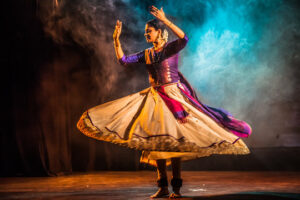
Kathak is a dance form native to North India. It originated within the Hindu temples representing mythological tales from epics and Hindu scriptures like Mahabharat and Ramyana and later spread across India through wandering storytellers or nomadic kathakars. It is a dance form which significantly developed with the Bhakti movement of Vaishnavism in North India.
Over the years, Kathak has evolved and transitioned diversely. This dance style has its origins in the Sanskrit Hindu text “Natya Shastra” on performing arts. The term “Kathak” is derived from the Vedic Sanskrit word “Katha,” which means “story,” whereas the term “kathaka,” which appears in a number of Hindu epics and manuscripts, refers to a storyteller. Therefore, the term “kathak” also refers to a male actor-dancer who is skilled in the art of telling stories through music and dance. This actor-dancer must be part of the Brahman Kathak caste and actively engaged in the artistic profession of this story-telling dance genre, which is thought to have derived its name from this caste.
In the medieval period, chiefly in the Mughal era Kathak started to evolve into a more erotic and sensuous form of dance which predominantly consisted of spiritual or religious themes. Although it still had the subtle message in it but went through improvisations to entertain the Muslim audience. Kathak was also patronised where the performer had to fulfil certain obligations and among them was to fulfil the sexual gratifications of the patron as it continued to function in a patriarchal society. Then after the coming in of the Colonial Britishers it had established itself into a dance form which was meant for court entertainment and the dancers were referred to as ‘nautch girls’ as the classical Kathak along with few other regional dances came to be called ‘nautch’ by the Britishers. Later some educated, high caste women paved the way for Kathak to be recognised with respectability.
There are various gharanas of Kathak which are various schools of thought within Kathak and mark different styles of performing. They are usually named after the places where they evolved and were performed at their royal courts. Kathak believes in the advaita philosophy which means ‘oneness’ or whole. This has led many scholars to argue that Kathak is an androgynous place as this oneness implies that the male Kathak dancers perform both male and female characters of the dance. However, according to Shivani Gupta, such assertions about dance and performance lead us to unknown areas of sexuality and gender, which Kathak as a dance attempts to avoid.
Carter states, “the relationship between dance and its socio-historical context is complex, for dance does not simply ‘reflect’ the value systems, customs, and habits of a society but actively constructs them. It produces as well as reproduces; speaks about society, and to it (Carter, 1990).”
According to Purnima Shah, Kathak allows the dancer to transcend gender as it has the capacity “to let the dancer transform gender roles through performance” which in turn makes the space androgynous. This claim of hers is based on the advaita philosophy of Kathak which is the idea of ‘oneness’ or ‘non-dualism’, which is displayed through the dance’s abhinaya aspect. According to her, this gives space for a gender neutral experience due to the fact that Kathak gives dancers the opportunity to use cultural symbolism or is culturally specific to reach “oneness,” or advaita, of her mind and body.
However, Shivani Gupta asserts that Shah contends, Kathak is an androgynous place in this argument while failing to consider both the whole space of Kathak and the subjectivities of its performers and that she negates the relationship between performance and culture. She elaborates on the patriarchal nature of Kathak by listing three points. First, through Natya Shastra which describes the role and function of women in relation to males by a male author and elucidates performance standards. Second, the tradition of guru-shishya parampara which provided space for the gharanas or schools of thought to evolve, confined the learning of Kathak. The Gharanas system has restricted the positions as authors or gurus to women where if they had occupied the position may pave the way for them to define the narratives of Kathak. Third, as the content and historiography of Kathak have been derived from hindu mythology which is the work of men that operated in a patriarchal setup and oppressed women for centuries “has resulted in making the performance and learning space of Kathak extremely gendered”.
Therefore, the captivating, exact, and throbbing footwork, as well as the elegant yet meticulous upper body carriage, hand movements, and facial expressions, reveal the varied cultural influences of Kathak. As a result, both Hindu and Muslim cultural components have been incorporated into Kathak, and is now established as a popular dance form.

